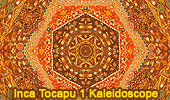Inca Tocapu
TOCAPU: Small square script found on Incan textiles and wooden vases.
An Inca textile specialty was the manufacture of the so-called tocapu, which consisted of small figures of a large pattern with certain drawings repeated; they
adorned the most luxurious garments with them. It is possible the tocapu originated during the Wari
culture.
Native Peruvian clothing and blankets frequently contained abstract geometrical symbols called tocapu, which were discretely located within a rectangular or square border. On clothing, each tocapu could be placed either in a linear pattern across the waist or in a grid pattern covering the whole surface. It is believed that these geometrical designs denoted ethnic, political, or religious status. Cummins (1994) has analyzed one tocapu that represents Tambotoco, the cave from which originated Manco Capac and his wife, the mythical founders of the Inca lineage. (The Jesuit and the Incas, Sabine Hyland, The University of Michigan Press, 2003, p. 136-137).
Tocapu textiles were the prerogative of members of the Inca imperial clan and higher level elite individuals. The extensively varied patterns which appear in the squares are thought to have encoded information conveying rank and privileges of the individuals wearing these garments, as well as indication that they controlled a variety of ethnicities within the empire (Rebecca Stone-Miller. Art of the Andes from Chavín
to Inca. New York: Thames and Hudson, 1995, p. 210).

|